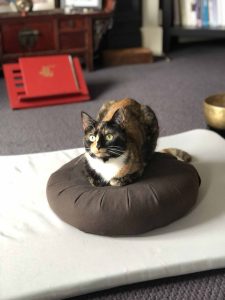Last week I shared some thoughts on the initial feedback offered by my kalyanamitra on my book manuscript . Crystal asked how my book could itself provide ‘spiritual friendship’ to other aspirants looking to bring together psychological and spiritual journeying. This week I wanted to share a second suggestion from Crystal: to consider the ending for the book and how I might give the reader a little more flavour as to what my practice life looks like now having travelled an integrated path. As I wrote about a few weeks back, finishing this book coincides with the 10 year anniversary of my meditation teacher training – so a decade later, how does practice look? And, how does it manifest in the ‘Practice of Human Being’.
“The Practice of Human Being” as a title speaks not only to the integration of two wisdom paths – psychotherapy and Buddhism, but also the interplay of formal practice with the everyday – or what is often referred to within the Buddhist tradition I practice, “post-meditation”. As you might imagine, any “day in the life of” narrative can only be indicative – any two practice sessions never look nor feel the same; and even in my daily life with all its routines, the more I pay attention to my experience, the less “samey” it becomes. But, let’s give this a shot and see where it takes us! I’ll start with the formal practice of sitting.
Practice, practice, practice
I wake. I stroke my cat, wiggle my toes, and remember my intention to practice. I slowly manoeuvre myself from under the duvet trying not to wake my wife (possible) nor my cat (not possible)…she jumps off the bed, and trots behind me as I go to the bathroom to clean my teeth, wash my face. Freshening up is part of the ritual; part of the intention to wake up in both the literal and aspirational sense. I am already honing my attention, noticing the tastes, smells, sensations in each action, in the transitions.
Back downstairs to my study. The room is dark in the early hours, so I turn on my SAD lamp. I plump up my zafu cushion, the buckwheat grains rustling, catching the attention of my cat. I light the two candles on my meditation shrine. I love the sound of the match strike, and I catch the odour of the newly lit match. I am remembering that the brand of matches I use is the same we always had at home in the family kitchen. The candles illuminate the shrine area. My shrine is in front of an Old Victorian fireplace, so the candles flicker in the draught. I remove a stick of incense from the box beside my meditation shrine, and I light it using the right hand candle – no special significance, just habit. I bring the lit incense stick to my head, throat, chest – to synchronise body, speech, and mind while I set my intention for practice. May this benefit all beings. I place the incense into its resting place of a sand-filled vase, a gift from close friends when I graduated with my PhD. I remind myself to clean out the old incense embers later.
 As I rest back onto the zafu, the scent of the incense begins to register. I hear the buckwheat rustle again. My cat looks up briefly, but then resumes her nap, curled up on the chair in the corner of the study. I reach for the blanket, fold my legs in half lotus, open my chant book. I pause…and then strike the gong three times. I listen until the sound recedes, and I chant the Four Dharmas of Gampopa.
As I rest back onto the zafu, the scent of the incense begins to register. I hear the buckwheat rustle again. My cat looks up briefly, but then resumes her nap, curled up on the chair in the corner of the study. I reach for the blanket, fold my legs in half lotus, open my chant book. I pause…and then strike the gong three times. I listen until the sound recedes, and I chant the Four Dharmas of Gampopa.
Grant your blessings so that my mind may be one with the dharma.
Grant your blessings so that dharma may progress along the path.
Grant your blessings so that the path may clarify confusion.
Grant your blessings so that confusion may dawn as wisdom.
On other days there are more chants, but today is a session of ‘simply sitting’. I close my chant book, put it to one side and put on my glasses. Doing so brings the fine detail of the Victorian fireplace into focus. I haven’t always needed glasses during practice, but I find it helps me relax my gaze and soften my face. I appreciate the wisps of smoke from the incense across the front of the fireplace. I begin to settle in my posture, feeling the length of my back, the openness in my chest. I bring my attention to the breath, riding the in and out breath for a few minutes, each out breath feels like dropping an anchor into the ocean below the waves of experience.
After 5 minutes or so, I raise my gaze – I am now looking straight out. I sit in “open awareness”, no object in particular, just allowing my senses to open to sights, sounds, tastes, smells, physical sensations and noticing where my attention goes. I note that process – like the lens of a wide angled camera, awareness open to the full panorama, zooming in to whatever sense experience that becomes the object of attention. In just noticing, awareness returns. “Touch and go”. The psycho-naut in me is fascinated how mind works and does all this without ‘me’….if I let it! Of course, thoughts arise. Sometimes these thoughts hijack me, taking me on cross-country jaunt having exited the metaphorical highway of aware presence. Early on in my meditation career, the main practice was to come back to the breath; to return again…and again…and again to awareness. The muscle of mindfulness.
But these days, when a thought arises, it simply becomes part of the perceptual display. I turn my awareness around and look for the ‘me’ that is thinking, I cannot find it. Nor can I find the experiencer of the sight, the sound, the taste, the smell, nor the experiencer of the subtle vibrancy in my heart and chest. In that recognition, I settle back into the back of my body, and rest again in open awareness….but not before I indulge in a little of the story of how that sensation in my chest used to be so much more pronounced. I take a moment of appreciating my practice and feeling gratitude in finding these teachings, and to all those who have enabled that – in my lifetime, but also the lineage of practitioners in which I belong. I am touched and moved, my heart opens in acknowledgement, and tears come from that tender spot.
Some 40 minutes pass – during which there are a multitude of experiences. An oft used metaphor is an ocean with waves. Awareness is the depth of the ocean; each sensory experience, each mental event, the waves. Just like the waves are made of the same water as the ocean, thoughts, feelings, emotions are no different from awareness. Each session brings a different set of waves; some sessions are stormier, some days more calm…but whether still or moving, awareness of experience remains consistent; the depth of the ocean remains undisturbed.
If there is one phrase I could use to describe how my practice informs my human being now, it would be the switch in allegiance from the contents of experience to the awareness or experiencing itself: rather than being caught in the waves, I am practicing resting in the ocean. I am building faith that the depths are not affected, and this depth is always there no matter how tempestuous life feels.
 Perhaps the purest of psycho-nauts, the ultimate of phenomenologists could “practice, practice, practice” and wake up. Indeed, this is what the Buddha did – he sat and noticed his experience, and recognised the nature of mind and its workings. I, like many others, have benefitted in the system of teachings developed since the Buddha; a system that points out the nature of mind. So my practice is supported by that scaffold. Waking up requires the development of wisdom, or prajna. Since taking the vow to become a Vajrayana practitioner, one teaching that I have benefitted from studying, contemplating, and meditating is that of the three kayas…indeed, I mentioned them just last week. Once we are introduced to the kayas, we see them permeating everything: body (nirmanakaya), speech (sambhogakaya) and mind (dharmakaya) for example. And so now in my practice, I see these three kayas making up my experience.
Perhaps the purest of psycho-nauts, the ultimate of phenomenologists could “practice, practice, practice” and wake up. Indeed, this is what the Buddha did – he sat and noticed his experience, and recognised the nature of mind and its workings. I, like many others, have benefitted in the system of teachings developed since the Buddha; a system that points out the nature of mind. So my practice is supported by that scaffold. Waking up requires the development of wisdom, or prajna. Since taking the vow to become a Vajrayana practitioner, one teaching that I have benefitted from studying, contemplating, and meditating is that of the three kayas…indeed, I mentioned them just last week. Once we are introduced to the kayas, we see them permeating everything: body (nirmanakaya), speech (sambhogakaya) and mind (dharmakaya) for example. And so now in my practice, I see these three kayas making up my experience.
The highest of Buddhist teachings, Dzogchen, say this…
Imagine a sky, empty, spacious, and pure from the beginning; its essence is like this.
Imagine a sun, luminous, clear, unobstructed, and spontaneously present; its nature is like this.
Imagine that sun shining out impartially on us and all things, penetrating all directions; its energy, which is the manifestation of compassion, is like this: Nothing can obstruct it and it pervades everywhere.
As I practice, I can recognise the essence of meditation has no experiencer, simply awareness itself (the dharmakaya); and yet even without a subject, there is still a quality or nature of knowing (the nirmanakaya); And because of this essence and nature, the energy of experiencing unfolds (the sambhogakaya).
These first hand experiences in meditation are undoubtedly shifting how I see my world; how I experience being a human being. And by extension, shifting how I see my practice as a Humanistic psychotherapist. I’ll maybe save a Buddhist critique and commentary on Jean-Paul Sartre’s famous dictum “existence precedes essence” for another time! And also for another time (probably next week) reflection on how all of this moves from the cushion into the everyday.

